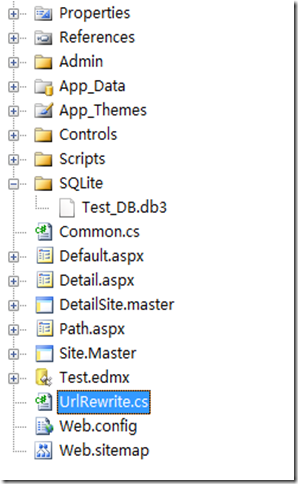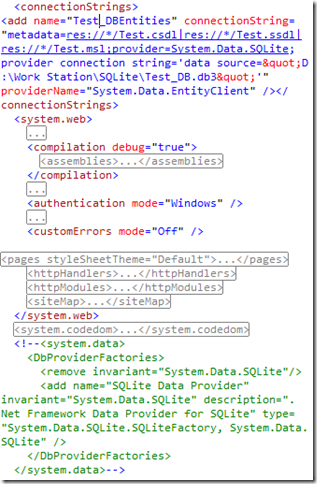Problem about SQLite and Linq to Entities
I have a web project developed in VS2008, which use System.Data.SQLite for .Net 2.0 and Linq to Entities to access data.
Here is the source layout:
You can see that i have a SQLite database Test_DB.db3 in SQLite folder. In my develop machine, i use connectiongstring created by Linq to Entities named “Test_DBEntities”, and don’t have the DBProviderFactories section, it run well. The Default.aspx page display data and the pages in Admin folder manage the data.
I publish the website in my product machine, it can not run, the error is “Could not load the assembly System.Data.SQLite”,
I search a solution, which ask me add the DBProviderFactories to the web.config file and add new reference to System.Data.SQLite.Linq.ddl. After do this, i can view the Default.aspx which display data. But i can not manage my data through the pages in Admin folder. I get error “Can not open the database file”, some people said the database can not in App_Data, but my file is not in App_Data, i still get the error.
I feel strange when i view the default.aspx, Test.edmx get data successfully, but when i view pages in Admin, for example, Manage.aspx, it will get the error “Can not open the database file”, The Manage.aspx get data only, no else. Following is my code to access data:
using (Test_DBEntities osDataContext = new Test_DBEntities(Common.GetConnString()))
{
OS_Module module = osDataContext.OS_Module.First<OS_Module>(m => m.Status == "Y" && m.ModuleValue == this.ModuleValue);
this.modelTitle.InnerHtml = module.ModuleTitle;
this.modelDetail.InnerHtml = Server.HtmlDecode(module.ModuleDetail);
}
I can use Default.aspx display different data, which get data successfully each time, but when display data use Manage.aspx in Admin folder, i will get the error “Can not open the database file”.
Any one who gets a solution, please comment here. Thanks very much!


